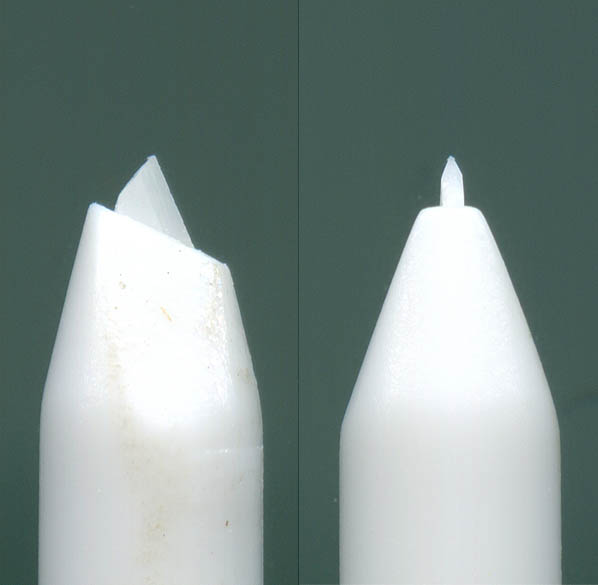Blog
Slice
March 23rd, 2012
While working on the San Salvador paper model for the Maritime Museum of San Diego, the issue of child safety came up, specifically the use of craft knives (i.e. X-acto). Mulling this around in my head, I remembered that there are new craft knives with ceramic blades. These are supposed to be safer than traditional metal blades. So, I picked up the Slice Precision Cutter. Scotch makes one, too, but there is hardly a tip on it.
Designed by award-winning designer Karim Rashid, the Slice cutter is sleek and stylish; it’s a simple design for a simple tool. It feels good in the hand, and has a weighted end both for balance and for adding some substance to an otherwise light-as-a-feather tool.
The ceramic blade is no thicker than a regular X-acto blade, and cuts almost as well. It’s designed for cutting thin media like printing paper and thin cardstock. Regular craft blades can cut much thicker materials (they have longer blades). The cuts, compared to metal blades, are identical. They cut through cleanly. But, because of the lack of a razor-sharp blade, the Slice is not as fast to cut with. It also makes a decent scoring tool if you use very little pressure. I personally use my X-acto blade to score (saves time).
Cutting accurately is an issue. Because the blade is so short, the holder obscures the cutting path. I found myself cocking my head to be able to see where the blade is in order to control it. The unnatural viewing angle slowed cutting time even further. It also seemed to pull to the right a tad, but I don’t know if that’s due the blade or my odd viewing angle.
“Safer than craft knives.” Yes, very true! But, the tip is still pretty sharp. It’s not a toy, but it’s safe for kids. The package recommends kids six years and older.
“Stays sharp, never rusts.” I don’t know about staying sharp (time will tell), but it can break if you apply excessive pressure and are using a hard cutting surface. I used a self-healing cutting mat, as I always use. And, it definitely will not rust since it is ceramic.
“Ideal for intricate shapes.” Not really. I found myself applying a little more pressure to cut all of the way through printing paper versus using a metal blade. The force of the ceramic blade pulling on the paper tends to tear apart intricate shapes. Stick to a sharp, new metal blade for that.
One nice thing that I discovered is located on the back of the box: “A portion of your purchase price is donated to fund Autism research.” It’s nice to know that I’m helping out a worthy cause. Sadly, this text is in very tiny print; I wish they had made this text much more prominent.
All-in-all, it’s a good cutting tool almost equal to a metal blade, although it’s more suited for general crafting than for detailed work. Safety-minded adults and teachers can feel better about letting youngsters use the Slice. But, it does have a sharp tip that will cut flesh if enough force is applied, so supervision is always a good idea.
Disclosure of Material Connection: Some of the links in this post are affiliate links—as an Amazon associate, I earn from qualifying products.




